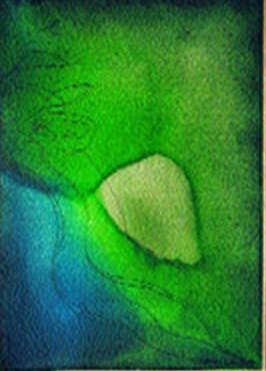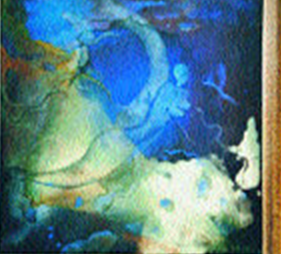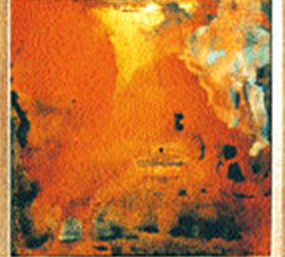Rokeya Sultana
This is a collection of articles archived for the excellence of their content. Readers will be able to edit existing articles and post new articles directly |
Rokeya Sultana
Undeterred freedom
By Amra Ali
The vivid compositions of this artist from Bengal move in fluid motions to represent her heritage derived from the colour of its folk art and music. Or perhaps they speak of Rokeya’s own strength of liberation from the confining South Asian limits …
Rokeya Sultana’s early memories take her back to a childhood in Rawalpindi when she was about nine or ten years old. Her father, a senior government official was stationed in West Pakistan from 1960-70, after which her family moved back to Dacca. Now teaching printmaking at the Institute of Fine Arts at the University of Dacca, Rokeya is recognized as one of Bangladesh’s most acclaimed artists; having won many prestigious awards, such as the Grand Prize at the 3rd Bharat Bhavan International Print Biennial, India in 1995 and the Bangladesh Shipkala Academy National Award for Best Work in 1998 and 2002. The artist recently revisited Pakistan after about a decade where she was here last for her first solo at Chawakandi Art. In September, Karachiites were treated to Rokeya’s newest paintings in another solo exhibition at the same venue.
This exhibition — part of her Air, Water, Earth — series presents itself as a riot of colours, of flaming vermilions, cadmiums and shades of crimson. The compositions that are dictated by a fluidity of form evoke a feeling of unbound freedom that speaks on many levels. Could it represent the celebration of her Bengali heritage derived from the colour of its folk art and its music and its light? Could it also be the voice of the liberated South Asian woman, whose inner self seeks to strengthen and grow?
Perhaps indirectly, and in a broader context of understanding, it is seen as effortlessly reasserting the dominance of the two dimensional painted surface as one which continues to evolve amidst many new mediums and interventions within the contemporary framework of expression. The painted canvas or paper has stood not only as the most popular art form, but has withstood the impact of technological advances due to its historical continuity and relevance to the creative expression of the Subcontinent.
“Painting”, says Rokeya, in an interview published in Jamini, “is an indirect statement.” For a more immediate statement one could make a poster, but for her, art should be contemplative, so that when one approaches art one should be approaching something transcendental. It then becomes an inner dialogue that takes you on an uncharted journey led by memory and thought. The primary source of her inspiration, she tells me, comes from nature.
It was when she was doing her Masters at the Vishwa Bharti University that the landscape at Shantineketan, with its winding rivers, meadows, swamps and palm trees re-affirmed the source of her inner most awareness and creative imagination. Thus started her spiritual journey that was nurtured by teachers such as Lalu Prasad, Somnath Hore and Sanat Kar and others. She traces Mohammad Kibria and Shafiuddin Ahmed as her direct teachers who played an important role in cultivating her viewpoint.
Rokeya was born in Chittagong in 1958, in a middle class Bengali family with four sisters and three brothers. She remembers that her elder sisters also painted, but used to copy the pictures of Abindranath Tagore and Nadalal Bose. But she always chose to take the more different and difficult route, to stay a little distanced from her peers, and used to enjoy being on her own. It was very early on in life that she had started to dream of joining Art College. After a considerable resistance by her family, she was eventually able to join the Dhaka Art College, where she recalls that the first two years were nightmarish, because she had to stay outdoors and paint till sunset. This was unthinkable for a Bengali girl in the 70s, and she faced much difficulty with her family. Of course, she says that it was much safer then compared to what it is like today. Resistance and gender discrimination helped her to acquire a determination that has stayed with her.
Rokeya’s paintings have focused on women’s issues and have been the voice of the feminist who stood up against prejudice, inspired by Bangladeshi women pioneers like Novera Ahmad. Through the seventies, Rokeya evolved amidst the significant presence of women artists like Nazlee Laila Mansur, Dilara Begum Jolly, Naima Haq and others. Through the 80s, she was inspired by Farida Zaman, Zakia Aziz, and Shamim Skikdar. Novera Ahmad, born in 1930, was the first sculptor of the country. On her return to Dacca from an art education in London, she found little technical or financial support to do sculpture. She therefore abandoned the method of modeling and casting and improvised to work with local materials like wood, clay and cement.
Combining her Western training with her Eastern environment, she became more aware of her own roots and began a journey to engage in a language that reflected these concerns for a cultural identity. However, her desire to tread into sculpture was frowned upon as un-Islamic and she later moved to live in Paris. Like Novera, Rokeya has also looked towards experimentation, perhaps not so much in her medium, as much as in her subject matter and application of pigment and line. Her references continued to relate to folk art and culture of her own environment in order to locate a meaningful synthesis of the old and the new.
Her earlier series of paintings and prints ‘Madonna and Child’, following some years after the birth of her only daughter, were a celebration of her motherhood. Rokeya’s Madonna draped in a Magenta sari stood as a symbol, and as Mustafa Zaman writes, ‘gradually became a means to formulate a more complex discourse steeped in apprehension, uncertainty as well as in hope.’ The choice of blatantly feminine colours and scenes from the everyday lives of women did more than disrupt the chord of a predominantly male structural hierarchy, but opened new doors of creativity for the Bengali female psyche and spirituality to be explored. Her print ‘Madonna in a Bus’ won her the coveted Bharat Bhavan award. Her work in the ’90s was mostly etching done in aquatint, lithograph, dry point and soft ground. Printmaking that she has continued to explore has given her the freedom to fuse her mark making, washes and linear quality to shape the multiplicity of her individualistic aesthetic concerns.
In the present exhibition, her medium is guache tempera on rice paper, mounted onto the surface of canvas. Traces of the linear elements of her earlier prints, though still visible, seem to have undergone a metamorphosis. Each canvas is drenched in a single colour and its possibilities. In passing, she adds that by saying less, and using a single colour on each canvas, she is probably saying more; an interesting approach that seeks humility and humbleness towards the medium and the intuitive process that filters thoughts and perceptions on many unspoken and complex levels. Talking about painting on the conventional canvas in this age of technological advances and experimentation, she smiles and adds that the sun still shines and the moon still appears. She follows what one of her teachers advised her… ‘to keep looking straight and moving ahead with her work…the truthfulness of that tradition will have a smell its own…’



